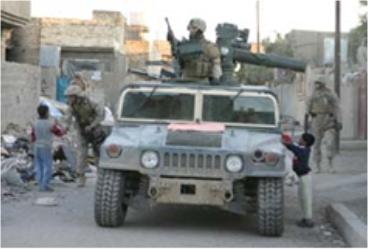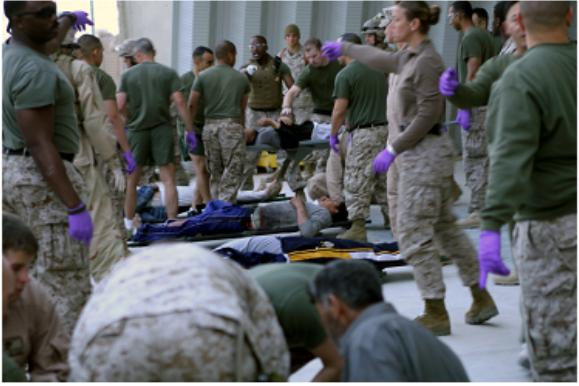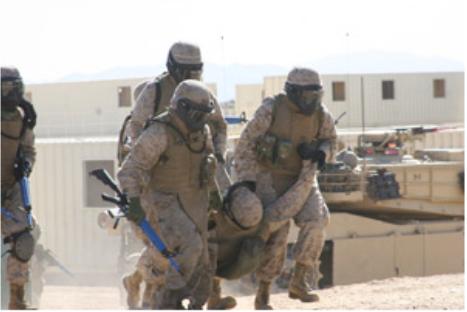FMST Student Manual - 2008 Web Edition*
UNITED STATES MARINE CORPS
Field Medical Training Battalion
Camp Lejeune
FMST
1303
Medical Support for Military Operations in Urban Terrain (MOUT)
TERMINAL LEARNING OBJECTIVES
1.
Given an urban combat environment, individual combat
equipment, and standard field medical equipment and supplies, provide medical
support for Military Operations in Urban Terrain (MOUT), to meet mission
requirements. (FMST-HSS-1303)
ENABLING LEARNING OBJECTIVES
1.
Without the aid of references,
identify the definition of urban warfare, per the student handout.
(FMST-HSS-1303a)
2.
Without the aid of references,
given a list, identify the potential health threats of Military Operations in
Urban Terrain (MOUT), per the student handout. (FMST-HSS-1303b)
3.
Without the aid of references,
given a list, identify the special requirements of casualty evacuation (CASEVAC)
in MOUT, per the student handout. (FMST-HSS-1303c)
4.
Without the aid of references, given the requirement in a
simulated combat scenario, operate in a MOUT environment, to meet mission
requirements per the student handout. (FMST-HSS-1303d)
1.
INTRODUCTION
Background
- throughout history, battles have been fought on urbanized terrain. Recent
examples are Beirut, Panama City, Mogadishu, and Iraq. It is impossible to
develop one set of tactics, techniques and procedures (TTP’s) that can be
applied to every scenario. Combatants and medical providers are required to
quickly adapt to each mission, terrain, and situation.
Definition - urban warfare, or MOUT, is best defined
as those military actions planned and conducted on a terrain where man-made
structures impact the tactical options available to the commander. This terrain
is characterized as a four-dimensional (air, buildings, streets, and subways)
battlefield with the following features:
-
Considerable rubble.
-
Ready-made fortified fighting positions.
- An
isolating effect on all combatants.
2.
CONSIDERATIONS OF MOUT

FALLUJAH,
Iraq - A
vehicle gunner with 1st Battalion, 6th Marine Regiment, looks out on the
city as his unit patrols the back alleyways of Fallujah. The unit
typically patrols the city streets several times a day, maintaining a
strong military presence here and searching for insurgents and illegal
arms. |
The
military commander must take many factors into consideration when planning MOUT
operations. Two of which, terrain and rules of engagement are discussed here:
Terrain
- four-dimensional battlefield.
- Enemy
observation positions are likely in high, isolated structures such as steeples
or lone high-rise buildings.
-
Assaulting forces can become quickly isolated, confused and cut-off by a tangle
of unfamiliar structures.
- Small assaulting units are at a great disadvantage due to
multiple floors, rooms, stairways, and doors. The enemy may make great use of
these obstacles to inflict serious losses.
Rules of Engagement - “US Forces and allies operate
with restrictive Rules of Engagement (ROE), reflecting the morals and values
considered proper for a civilized society. Unfortunately, the tactical
advantage will often go to the belligerent, who disregards or actively endangers
the safety of civilians” (PHTLS 6th ed. P 586). Therefore, it is
important to remember that every action has consequences. ROE may change from
day to day, or from situation to situation. ROE are designed to:
- Avoid
alienation of the local population.
- Reduce
the risk of adverse world opinion.
-
Preserve structures and facilities for future use.
-
Preserve vital cultural facilities and grounds.
3.
MEDICAL CONSIDERATIONS OF MOUT
Casualty
rates are generally higher than conventional battles. Explosions are the most
frequent cause of injury in an urban setting. These explosions may be generated
from tanks, mortars, or improvised explosive devices (IED’s). These explosions
are likely to produce blast related injuries which are covered in a separate
lesson. Small units may be spread out across a large area. Unit training in
the practice of “self-aid” and “buddy-aid” is essential. Each combatant should
be able to quickly and effectively apply a tourniquet, field dressing, and
hemostatic agent.

AL TAQADDUM, Iraq– Servicemembers help triage injured Iraqi
civilians outside of Taqaddum’s medical facility after a suicide truck
bomb exploded in northern Habbiniyah. |
Potential Health Threats of MOUT include:
Psychological Casualties
In
addition to blast injuries, units are likely to experience an increase in
psychological injuries. This is due to lengthy exposure to factors
resulting from a constant threat of a hidden enemy. Prolonged fear of
sniper fire and hidden IED’s along with the repeated sight of the dead and
dying are predominant factors leading to combat stress casualties.
Medical units should be prepared to treat these individuals.
Civilian Casualties
Medical units must be prepared for
the influx of large numbers of civilian casualties. Units should prepare for
the possibility of geriatric and pediatric patients. Large numbers of civilians
could overwhelm the capabilities of military medical units. Units should,
therefore, establish a plan for this possibility prior to engaging.
Infectious Disease
Areas experiencing urban combat are
likely to have many infectious diseases in the area. The problem will be worse
due to poor general sanitation measures and limited amount of public health
services.
Animals:
Diseases can also be carried by the many animals in the area (rats, mice, dogs,
etc.).
People:
Interacting with the civilian populace or enemy prisoners of war can expose you
or your Marines to such diseases as malaria, tuberculosis or leishmaniasis.
Sexually transmitted diseases such as gonorrhea, syphilis, hepatitis, and HIV
may also be prevalent.
Water: Potable water will be limited. Troops in
urban conflict can consume up to 5 quarts per day on a normal occasion and 12
quarts of water per day in extreme heat environments. If the demand
for water is greater than the ability to re-supply, they may be tempted to drink
water from local sources. This exposes them to hepatitis, intestinal parasites
and industrial toxins.

Twentynine Palms, CA- Marines from 3rd Battalion, 5th
Marine Regiment, carry a ‘casualty’ to safety in the urban assault lane of
the training at Range 215. The MOUT facilities were built to replicate the
actual environment that Marines will face when deployed. |
Casualty Evacuation
Moving casualties in an urban
environment can be difficult and time consuming. Moving a litter patient only a
few hundred yards could take an hour or more. Ground evacuation vehicles will
require heavy armor that can withstand small arms fire as well as rocket
propelled grenades (RPG) and IED’s. Helicopter evacuation is difficult due to
the tight operating environment. They too are susceptible to small arms fire
and RPG’s.
Special equipment requirements of CASEVAC
Simply
finding casualties in an urban environment can be difficult. Explosions can
cause buildings to crumble trapping patients inside. Vehicles can crash due to
explosions, hostile fire, or operator error. Events such as these may lead to
complicated rescue efforts that require special equipment such as: axes,
crowbars, jacks, ropes, collapsible litters, and cutting tools.
REFERENCE
Identify the predominant
factors that lead to combat stress casualties in a MOUT environment.
List three sources of
infectious disease that are found in a MOUT environment.
Identify some events that may
lead to complicated CASEVAC efforts in a MOUT environment.
|
*The FMST Student
Manual was produced by the Field Medical Training Battalion-East, Camp Lejeune,
North Carolina. This 2008 web edition has been enhanced by the Brookside
Associates, Ltd., preserving all of the original text material, while
augmenting, modifying, eliminating or replacing some of the graphics to comply with
privacy and copyright laws, and to enhance the training value. These
enhancements are marked with a red box
□
and are C. 2008, with all rights
reserved.
|
|



